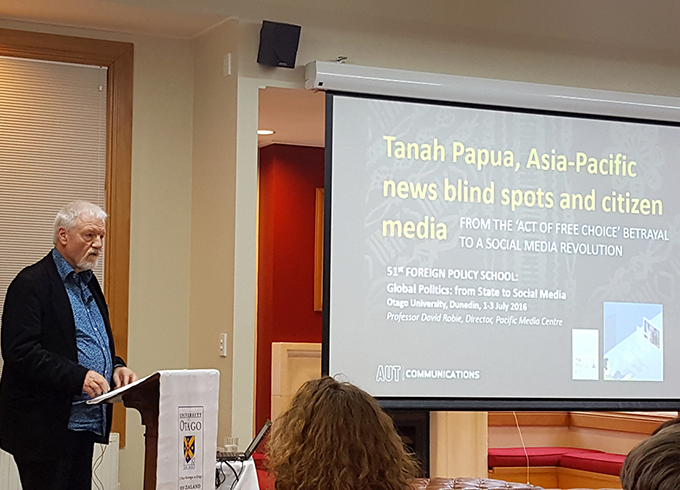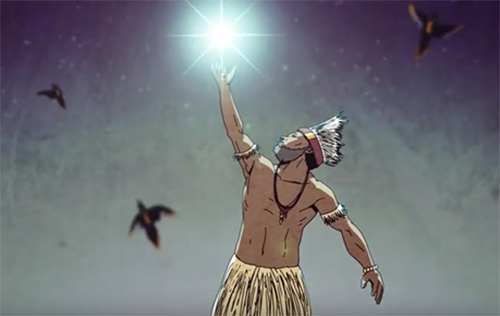
New Zealand news media are “ignoring” the biggest story in the Pacific region in spite of a social media revolution taking the storytelling to the world.
This is the view of a journalist and media educator expressed at the Otago Foreign Policy School at the weekend by Pacific Media Centre director Professor David Robie.

In a multimedia paper entitled “Tanah Papua, Asia Pacific news blind spots and citizen media: From ‘Act of Free Choice’ betrayal to a social media revolution”, Dr Robie spanned a half century of human rights atrocities and gagged communications for the indigenous people in the Indonesian-ruled region of West Papua.
He praised two New Zealand media crews – from Māori Television’s Native Affairs and Radio New Zealand International – who took advantage of an apparently more relaxed stance of Indonesian officials over West Papua since the election of President Joko Widodo to obtain visas to “go to see for themselves” last year.
However, he said, “a disappointing outcome from the two visits to West Papua officially for the first time by New Zealand journalists … is that so far it has not encouraged other media in New Zealand to take up the challenge.”
He praised RNZI for its consistent and exemplary coverage of West Papua affairs for many years, setting a standard for the rest of the media to emulate.
Dr Robie referred to Australian investigative journalist of SBS Dateline Mark Davis who had twice visited West Papua as an “underground, illegal” journalist, and “thus was not popular with the authorities in Jakarta”.
‘Open’ policy hypocrisy
“But in May 2014, he also had the opportunity for rare access to the secretive region to find “open policy” hypocrisy about what is really happening in the struggle over self-determination with Indonesia.”
Praising the TV report for its nuanced and revealing overview, he said Davis had also exposed the Indonesian double standards over the media.
“Was it really West Papua’s New Dawn?,” Dr Robie asked, referring to the programme’s title.
“Hardly at all. And a major question for journalists is just how much do we offer a fig leaf to Jakarta by cooperating with these heavily ‘minded’ see-no-evil, hear-no-evil visits to the region.”
Earlier this year, a Catholic Justice and Peace Commission fact-finding mission from Australia visited West Papua in lieu of the Pacific Islands Forum summit’s initiative which had been decided at the Port Moresby summit in September 2015 but blocked by Indonesian authorities.
The mission produced a devastating report in May 2016 that called for urgent action to support Papuans who were “living with unrelenting intimidation and brutality”.
“The situation in West Papua is fast approaching a tipping point. In less than five years, the position of Papuans in their own land will be worse than precarious,” the report said.
‘Demographic tidal wave’
“They are already experiencing a demographic tidal wave. Ruthless Indonesian political, economic, social and cultural domination threatens to engulf the proud people who have inhabited the land they call Tanah Papua for thousands of years.”
Despite an announcement in May 2015 by President Widodo that journalists would have free access to West Papua, media access was still restricted, said the report.
“There is no freedom of expression. Almost 40 political prisoners are currently in jail – [written before 2000 plus arrests on May 1/2 this year and then a further 1000 plus arrests on June 15 — customary land tights are not protected and there is no systemic policy of affirmative action.
“West Papuan human rights are also not protected. Throughout 2015, the Indonesian security forces had targeted young people in particular, all of whom have been unarmed.”
@DavidRobie silences room with powerful reminder of importance of the freedom of #media and power of #media for truth #balibo #ofps16
— Jennifer Andrewes (@JAndrewesNZ) July 2, 2016
Dr Robie outlined how in spite of a dramatic global social media strategy – led by high profile groups such as the Free West Papua Campaign – in the past couple of years having boosted “awareness of the West Papuan people’s story” around the world, this was still largely shut out by the New Zealand media.
He paid tribute to the so-called Balibo Five and Roger East in Timor-Leste in 1975 at the time of the Indonesian invasion, saying their tragic deaths had been a game-changer.
‘While journalists had previously died in conflict and war zones, the Balibo massacre and subsequent execution of Roger East were believed to be the first time journalists had been killed because they were journalists,” he said.
Dr Robie also referred to other “black spot” stories shunned by the New Zealand mainstream media, such as the Kanak independence struggle in the 1980s (which he had personally reported on) with a self-determination referendum due by 2018; the militarisation of the Mariana Islands in the North Pacific; the “Nuclear zero” lawsuit by the republic of the Marshall Islands against the nine nuclear powers in the International Court of Justice; and recent anti-government unrest in the universities of Papua New Guinea which climaxed with heavily armed police firing on students, wounding 23.
Answering his own rhetorical question about why many New Zealand media were not giving attention to important Pacific stories, he said: “Primarily because we have no genuine tradition of foreign correspondents and foreign editors in New Zealand, so the specialist knowledge required is seriously lacking.”
He said there was a need for university-based journalism programme-sponsored media to “step up” and offer models for independent, alternative media, an issue he is due to address at next week’s World Journalism Education Congress (WJEC) conference in Auckland.










































[…] Shackleton, widow of journalist Greg Shackleton, one of the Balibo Five killed by Indonesian special forces at that Timorese border town of that name on 16 October 1975, […]
Comments are closed.